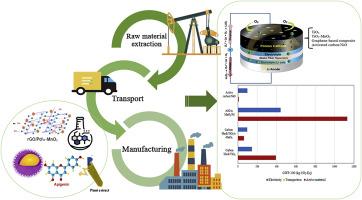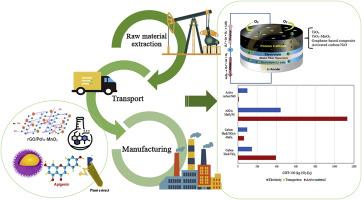Investigating the environmental impacts of lithium-oxygen battery cathode production: A comprehensive assessment of the effects associated with oxygen cathode manufacturing
IF 9.7
1区 环境科学与生态学
Q1 ENGINEERING, ENVIRONMENTAL
引用次数: 0
Abstract
Lithium-oxygen batteries offer remarkably high energy density compared to current lithium-ion batteries. The key to their electrochemical performance lies in the processes occurring at the air cathode. However, the complexity of these reactions, coupled with the by-products generated during discharge, can make the reaction process slow or impede their efficiency. This study evaluates the environmental impact of high-efficiency lithium-oxygen batteries cathodes, including titanium oxide composites, graphene-based composites and activated carbon-based composites, through a life cycle assessment across 18 impact categories using a cradle-to-gate approach with a functional unit of 25 kWh. Results show that active material production was the largest contributor to environmental impact, particularly Global Warming Potential. Among the evaluated cathodes, reduced graphene oxide/α-mnaganese oxide/palladium (rGO/α-MnO2/Pd) demonstrated the highest environmental impact, with a global warming potential of 1130.71 kg carbon dioxide from active material production, due to its energy-intensive synthesis and the use of chemicals like sulfuric acid, sodium borohydride, hydrochloric acid, and hydrogen peroxide. Additionally, the rGO/α-MnO2/Pd cathode had the highest Human Toxicity Potential and Ozone Depletion Potential. Batteries with graphene-based cathodes achieved a specific capacity of 7500 mAh.g−1, underscoring their performance potential while highlighting the need for more sustainable cathode manufacturing methods. These findings emphasize the environmental considerations necessary for large-scale lithium-oxygen batteries implementation.


调查锂氧电池正极生产对环境的影响:全面评估与氧气阴极生产相关的影响
与目前的锂离子电池相比,锂氧电池具有极高的能量密度。其电化学性能的关键在于空气阴极的反应过程。然而,这些反应的复杂性,加上放电过程中产生的副产品,会使反应过程缓慢或影响其效率。本研究采用 "从摇篮到终点 "的方法,以 25 千瓦时为功能单位,通过对 18 个影响类别进行生命周期评估,评估了高效锂氧电池正极(包括氧化钛复合材料、石墨烯基复合材料和活性碳基复合材料)对环境的影响。结果表明,活性材料生产对环境影响最大,尤其是全球变暖潜势。在所评估的阴极中,还原氧化石墨烯/α-氧化锰/钯(rGO/α-MnO2/Pd)对环境的影响最大,由于其能源密集型合成以及硫酸、硼氢化钠、盐酸和过氧化氢等化学品的使用,活性材料生产产生的全球升温潜能值为 1130.71 千克二氧化碳。此外,rGO/α-MnO2/Pd 阴极的人体毒性潜能值和臭氧消耗潜能值最高。使用石墨烯基阴极的电池的比容量达到了 7500 mAh.g-1,凸显了其性能潜力,同时也强调了对更具可持续性的阴极制造方法的需求。这些发现强调了大规模实施锂氧电池所需的环境因素。
本文章由计算机程序翻译,如有差异,请以英文原文为准。
求助全文
约1分钟内获得全文
求助全文
来源期刊

Journal of Cleaner Production
环境科学-工程:环境
CiteScore
20.40
自引率
9.00%
发文量
4720
审稿时长
111 days
期刊介绍:
The Journal of Cleaner Production is an international, transdisciplinary journal that addresses and discusses theoretical and practical Cleaner Production, Environmental, and Sustainability issues. It aims to help societies become more sustainable by focusing on the concept of 'Cleaner Production', which aims at preventing waste production and increasing efficiencies in energy, water, resources, and human capital use. The journal serves as a platform for corporations, governments, education institutions, regions, and societies to engage in discussions and research related to Cleaner Production, environmental, and sustainability practices.
 求助内容:
求助内容: 应助结果提醒方式:
应助结果提醒方式:


